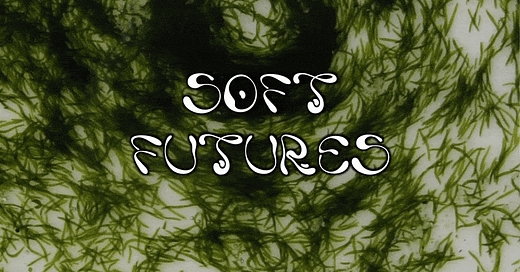Welcome to Soft Futures
A curated collection of materials science, synthetic organisms, and embodied technologies.
Soft Futures is a curated collection of materials and technologies. As the curator, I offer my personal and situated perspective on some of the niches of research I enjoy writing and reading about.
The broad focus of Soft Futures is on materials science. I am particularly interested in the ways in which bodies, whether organic or inorganic, living or nonliving, natural or artificial, grow, evolve, think, interact, and learn.
The keyword that captures the spirit of this collection is the concept of “softness” - a term that hints at adaptability, complexity, and memory.
What is “softness”?
There are ideas we intuitively understand, and yet somehow keep escaping the perimeters of language. Although I’ve worked in the field of soft matter, read countless papers about soft materials, and used the concept of softness many times in my writing, I still struggle to find a clear definition.
In science, softness encompasses more than just the ability of a material to change shape easily. It’s a word that encompasses a wide range of different states of matter, from colloids to gels, from foams to crystals. In technology, softness is a process: it refers to decentralized, systemic approaches that make complexity sustainable.
Soft Futures is an attempt to answer the question of softness in science and technology by approaching it from the bottom up - which is, in itself, a soft approach to a hard problem.
What all soft material systems have in common is their ability to transcend their boundaries, both physically and metaphorically. They build extensive networks, stretch out into their environments, incorporate foreign bodies, and grow out of their own skins.
In a way, Soft Futures is an attempt to answer the question of softness in science and technology by approaching it from the bottom up - which is, in itself, a soft approach to a hard problem. Instead of looking for a definition, I began looking around for real-world examples of materials that embodied some fundamental aspects of what I understood as “softness”. Since I started gathering elements for my collection, I’ve identified a handful of recurring ideas and unanswered questions:
Self-organization. In what ways does order emerge from chaos? How do material systems manage complexity without centralized control?
Hysteresis and dissipation. How does the passing of time affect material bodies? Can the cognitive function of “memory” emerge in nonliving matter?
Nonhuman agencies. What does it mean for a material to be intelligent or conscious? Are nonliving bodies ruled by determinism alone?
Life as we don’t know it. What does it mean for a body to be alive? Are any nonbiological forms of “life” possible?
Matter and information. Is matter simply a passive substrate on which we “inscribe” information? Are there other possible relationships between information and material systems?
Although I do not intend to directly address any of these problems, hopefully, as the project progresses and grows, some answers (and more questions) will begin to spontaneously take shape.
Before we get started, allow me to leave you with a short methodological note.
Collections, holobionts, and situated knowledges
Have you ever walked across the corridor of an old science department and looked into the dusty cabinets filled with mysterious specimens, faded labels, and forgotten samples? There was a time when scientific research was all about collecting things. Today, we cherish and celebrate collections of artworks, texts, artifacts, and images - but the practice of collecting has gradually lost its prominent place in science.
Collecting is, by definition, a very personal endeavor. There is always an element of subjective vision that dictates what deserves a place on the dusty shelf and what, instead, is excluded. Often, the decision is made not because of the significance of each individual piece, but out of a wider, poetic feeling: a free process of association that circumvents the boundary of systematic thinking.
A collection is the epistemic equivalent of a holobiont: by juxtaposing wildly different objects, it produces a unique, localized ecology of knowledge.
Undoubtedly, this subjective gaze clashes with contemporary science’s aspiration to absolute objectivity. But, in an era where millions of papers are published annually - when no single person can aspire to grasp the direction of technological “progress” - is any objectivity in science communication even possible? Collecting is a precious and underestimated tool to navigate the super-human complexity of scientific knowledge production.
With Soft Futures, my aspiration is to weave a network of bodies and ideas from my own situated perspective. I have no ambition to teach or educate my readers about any specific field of science; you will not find scientific “news” or comprehensive explanations of emerging trends in research. Methodologically, the choice of a curated collection stems from my belief that science isn’t at all separated from other domains of culture. To me, intuition, curiosity, and wonder are tools as legitimate as any other to explore and inhabit scientific cultures.
In biology, the term “holobiont” refers to an organism resulting from the symbiotic encounter of different species. Each of the bodies that make up a holobiont emerges from radically different evolutionary path. The resulting assemblage is more than the sum of its parts, showing behaviors and functions that far surpass those of the individual organisms that make it up. Similarly, collections craft unprecedented connections between objects separated in time and space. A collection is the epistemic equivalent of a holobiont: by juxtaposing wildly different objects, it produces a unique, localized ecology of knowledge.
Subscribe to Soft Futures
Soft Futures takes the form of a blog and a weekly newsletter. Each week I share something new about a specific material that has captured my attention.




